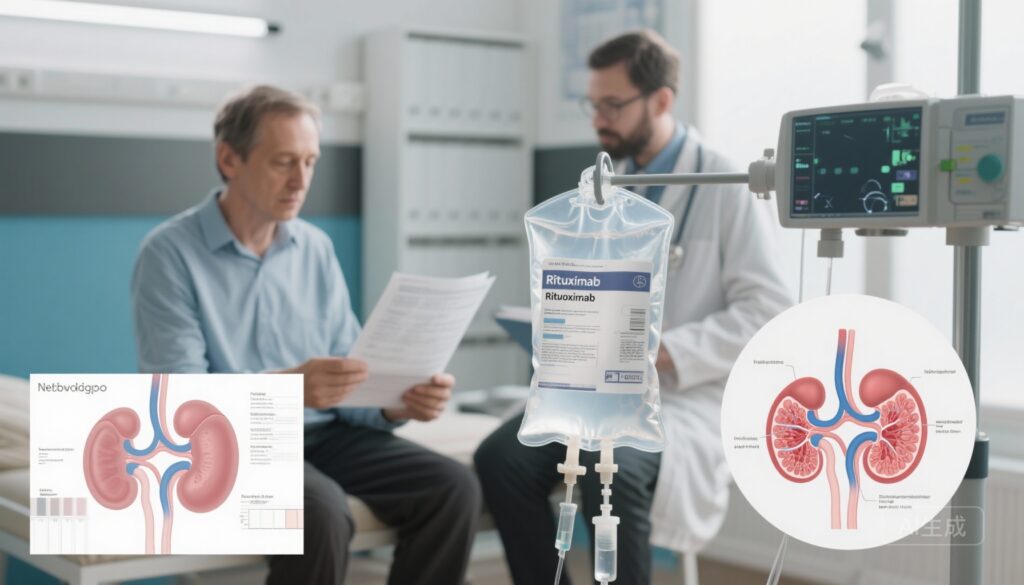Highlight
– In a double‑blind, placebo‑controlled randomized trial of adults with frequently relapsing nephrotic syndrome (FRNS) or steroid‑dependent nephrotic syndrome (SDNS), rituximab given at weeks 1, 2 and 25 increased the 49‑week relapse‑free rate to 87.4% versus 38.0% with placebo (P < .001).
– Rituximab reduced the hazard of relapse by approximately 84% (HR 0.16; 95% CI, 0.05–0.46).
– Infusion reactions were the most common adverse event; longer follow‑up is required to define durability, infection risk, and effects on immunoglobulins.
Background and disease burden
Relapsing nephrotic syndrome in adults — manifesting as frequently relapsing nephrotic syndrome (FRNS) or steroid‑dependent nephrotic syndrome (SDNS) — presents a therapeutic dilemma. Repeated courses of high‑dose corticosteroids and steroid‑sparing immunosuppressants are commonly used to maintain remission, but they confer cumulative toxicity (metabolic complications, infections, bone loss) and incomplete control. Rituximab, a monoclonal anti‑CD20 antibody that depletes B cells, has been used off‑label for steroid‑sparing in nephrotic syndrome with encouraging observational data and smaller trials in children. However, robust randomized evidence in adults has been limited. The JAMA multicenter randomized trial led by Isaka et al. addresses this gap by evaluating rituximab versus placebo in adult FRNS/SDNS with proteinuria in remission (<0.3 g/gCr).
Study design
This was a multicenter, double‑blind, randomized, placebo‑controlled trial conducted at 13 centers in Japan. Adults with FRNS or SDNS who were in remission (urine protein <0.3 g/gCr) were enrolled between September 1, 2020 and June 28, 2022, with final follow‑up on March 15, 2024. Seventy‑two participants were randomized 1:1 to receive either rituximab 375 mg/m2 intravenously (n = 36) or placebo (n = 36) at weeks 1, 2 and again at week 25. The planned follow‑up period was 49 weeks after randomization. The prespecified primary outcome was the proportion of patients who remained free of nephrotic‑range relapse (defined as urine protein ≥1.0 g/gCr on two consecutive measurements) at 49 weeks. Secondary outcomes included time to relapse, relapse rate, cumulative corticosteroid exposure and other clinically relevant endpoints (18 secondary outcomes reported). Safety endpoints included adverse events, with attention to infusion reactions and infection.
Key findings
Of 72 randomized participants (mean age 47.9 years; 56.1% female), 66 (92%) received the study drug at least once and were included in the analysis set. Main efficacy results were:
- Relapse‑free rate at 49 weeks: 87.4% (95% CI, 69.8%–95.1%) in the rituximab group versus 38.0% (95% CI, 22.1%–53.8%) in the placebo group (P < .001 by one‑sided log‑rank test).
- Median relapse‑free time: >49.0 weeks in the rituximab group (i.e., median not reached within follow‑up) and 30.8 weeks in the placebo group.
- Hazard ratio for relapse (stratified Cox model): 0.16 (95% CI, 0.05–0.46; P < .001), indicating an 84% relative reduction in risk of relapse with rituximab.
- Of 18 prespecified secondary outcomes, only one reached statistical significance favoring rituximab (the report does not indicate which endpoint in the summary provided), underscoring that the primary benefit was most clearly evident on relapse prevention.
Safety findings:
- Infusion reactions were the most common adverse event: 13 of 32 (40.6%) in the rituximab group experienced an infusion reaction versus 1 of 34 (2.9%) in the placebo group.
- Other adverse events, serious infections, hypogammaglobulinemia, and long‑term safety outcomes were not detailed in the summary; these require careful inspection of the full safety dataset and longer follow‑up.
Interpretation and clinical implications
This trial provides randomized evidence that rituximab substantially lowers the short‑term risk of nephrotic relapse in adults with FRNS or SDNS who are in remission at baseline. The magnitude of effect is large: an absolute difference in 49‑week relapse‑free rates of approximately 49 percentage points and a hazard ratio of 0.16. For clinicians, these data support considering rituximab as a relapse‑preventing strategy in selected adults with relapsing or steroid‑dependent disease, particularly when steroid toxicity is a concern or when earlier steroid‑sparing therapies have failed or are contraindicated.
Strengths
- Robust randomized, double‑blind, placebo‑controlled design across multiple centers increases internal validity.
- Clinically meaningful primary endpoint (relapse defined by objective proteinuria criteria) and prespecified time horizon of 49 weeks.
- Use of a contemporary dosing strategy with re‑dosing at week 25 addresses relapse prevention beyond a single early depletion.
Limitations and considerations
- Geographic and demographic scope: the trial was conducted exclusively in Japan. Generalizability to other ethnic groups and health systems should be considered cautiously, though biologic effects of B‑cell depletion are unlikely to differ substantially by region.
- Follow‑up duration of 49 weeks captures short‑term prevention of relapse but does not define long‑term durability, cumulative safety (notably infection risk and hypogammaglobulinemia), or effects on steroid‑related morbidity over years.
- Only one of 18 secondary outcomes was statistically significant; multiplicity and limited power for multiple secondary endpoints mean that inferences beyond relapse prevention should be cautious.
- Infusion reactions were common with rituximab; although most are manageable, they may require premedication and monitoring and can affect tolerability for some patients.
- Cost, access, and vaccination timing (particularly in the context of live and inactivated vaccines and pandemic considerations) remain practical challenges for implementation.
Biologic plausibility and mechanistic notes
Rituximab targets CD20 on B lymphocytes, resulting in peripheral B‑cell depletion. Several hypotheses link B cells to the pathogenesis of minimal‑change disease and other forms of nephrotic syndrome, including dysregulated antibody production, altered cytokine milieus, and effects on T‑cell–B‑cell crosstalk. B‑cell depletion can therefore interrupt pathogenic immune processes that precipitate podocyte injury and proteinuria, providing a mechanistic rationale for relapse prevention. The kinetics of B‑cell recovery after rituximab often correlate with risk of relapse, which motivates strategies of re‑dosing timed to B‑cell reconstitution in some protocols.
Where this fits in current practice
Current guideline statements (for example, the KDIGO 2021 glomerular disease guideline) acknowledge the potential role of rituximab in steroid‑dependent or frequently relapsing nephrotic syndrome, particularly when steroid toxicity is substantial or alternative agents are unsuitable. The randomized data from this trial strengthen that recommendation base for adults and may shift clinical practice toward earlier consideration of rituximab as a steroid‑sparing maintenance option. Individualized decisions should incorporate patient preferences, prior response to immunosuppression, comorbidities (infection risk, vaccination status), reproductive plans, and cost/access issues.
Unanswered questions and research agenda
- Longer‑term efficacy and safety: durability of remission beyond 1 year, cumulative infection risk, and impact on immunoglobulin levels require extended follow‑up.
- Optimal dosing and re‑dosing strategy: fixed re‑dosing (as used at week 25 in this trial) versus B‑cell–guided re‑treatment warrants comparison to optimize efficacy/safety balance and costs.
- Biomarkers predicting response: identifying patients most likely to benefit (or at risk of adverse events) would improve patient selection.
- Comparative effectiveness versus other steroid‑sparing agents (calcineurin inhibitors, mycophenolate, cyclophosphamide) for adult FRNS/SDNS in head‑to‑head randomized trials.
Expert commentary
Leading nephrology practice will likely view these results as a pivotal adult randomized confirmation of rituximab’s role in relapse prevention. The large effect size on the primary endpoint is impressive, but clinicians should interpret the data in the context of safety vigilance for infusion reactions and infections, and the need to individualize care. Until longer‑term outcomes are available, rituximab should be considered among the options for adults with FRNS/SDNS, particularly when steroid toxicity is unacceptable or other agents have failed.
Conclusions
The multicenter randomized trial by Isaka et al. demonstrates that rituximab substantially reduces the risk of nephrotic relapse over 49 weeks in adults with frequently relapsing or steroid‑dependent nephrotic syndrome. The findings provide a strong evidence base to support rituximab as an effective relapse‑preventing therapy in this population. Implementation should weigh benefits against infusion‑related reactions, infection risk, cost, and the need for longer‑term safety and durability data.
Funding and trial registration
Trial registration: Japan Registry of Clinical Trials: jRCT2051200045; University Hospital Medical Information Network Clinical Trials Registry: UMIN000041475. Funding sources are reported in the original JAMA publication.
References
1. Isaka Y, Sakaguchi Y, Shinzawa M, et al. Rituximab for Relapsing Nephrotic Syndrome in Adults: A Randomized Clinical Trial. JAMA. 2025 Nov 5:e2519316. doi:10.1001/jama.2025.19316. PMID: 41191364; PMCID: PMC12590383.
2. Kidney Disease: Improving Global Outcomes (KDIGO) Glomerular Diseases Work Group. KDIGO 2021 Clinical Practice Guideline for the Management of Glomerular Diseases. Kidney Int. 2021;100(4S):S1–S276.



